Anthurium: soil for planting and transplanting a flower
Anthurium - a beautiful semi-epiphyte with bright shiny leaves and flowers. Some varieties can also be grown indoors.
Content:
- Indoor plant description
- Planting and transplanting anthurium
- Proper flower care
- Pest and disease control
Indoor plant description
Anthurium belongs to herbaceous perennial plants of the aroid family. This delicate tropical flower has another name - flamingo. The leaves of the plant are dense, covered with a matte film, up to 20 cm long. The inflorescence is an ear, around which there is a colored veil-bracts. It is rolled up in a tube so that the ear is clearly visible. Natural varieties have crimson bracts. Modern varieties and hybrids have a variety of colors, from blue to red, there are varieties with a speckled bedspread. The flowers are fragrant.
After the flower has faded, the perianth turns green and becomes a leaf. Flowers are small, complex pollination system. In their place, round-shaped fruits are formed. Seeds ripen up to one and a half to two months. They must be sown immediately after collection. Reproduction of anthurium can be carried out by seeds after artificial pollination or vegetatively, by dividing a bush or cuttings. The second way is much easier and more productive. Anthurium has about 100 flowering hybrids. If propagated by seed, the properties of the parent variety are often not transmitted.
Anthurium juice is poisonous.
Despite the fact that there are about 500 species and varieties of this plant, the following are grown in room conditions:
- Anthurium Andre with red flowers of all shades or white. Andre Dakota is the most popular variety.
- Anthurium scherzerianum (Scherzer) up to 25 cm high and up to 40 cm wide. The leaves are arrow-shaped, the flowers are red, less often white or spotted. After the beginning of flowering, they appear continuously and bloom several pieces at a time. Flowering continues even in winter, but in summer the number of flowers is greater.
- Anthurium andreanum requires a higher temperature to grow and is therefore not common in apartments. The flowers are very large, cut for several weeks.
- Anthurium crystallinum is also demanding in terms of temperature and humidity. It is prized for its beautiful velvety leaves with silvery veins. The shape of the leaves is heart-shaped.
Planting and transplanting anthurium
When buying a flower in a store, they carefully examine its leaves. They must be resilient. Withered leaves indicate a recent drying out of the soil and will adversely affect the flower in the future. There should also be young buds. Anthurium is transplanted in the spring.
The indications for transplanting are roots that protrude not only from the drainage hole, but also from the ground from above.
They buy soil for bromeliads in a store or prepare it themselves, mixing part of coniferous, leafy soil, peat with part sphagnum moss or half a dose of coarse sand. You should get a loose substrate of a weakly acidic reaction, which allows air and moisture to pass through well. Charcoal is added to protect the roots from rotting.
The pot for the transplant is taken wide, but not deep, with a diameter of 3 cm larger than the previous one. Its size depends on what it is supposed to get from the flower.If you need a lot of flowers, take smaller dishes, for the formation of shoots for reproduction - more.
Features of flower transplant:
- A thick layer of expanded clay and crushed stone drainage is laid. Part of the prepared soil is poured on top.
- Water the ground in a flower pot. Wait until the old soil gets wet. Turn over the dishes with anthurium, tap on its lower edge so that the earth falls behind the walls. Support the surface with your hand.
- Having taken out a flower with a clod of earth, remove the remnants of the earth with a soft stick, which will not damage the delicate roots.
- When the excess soil has been removed, immerse the plant in the pot. Fill the space between the walls and roots with prepared soil.
- When all the roots are covered with earth, compact them from above to get rid of areas filled with air. Do not water for 2 days. This will force the roots of the plant to grow into the soil in search of moisture.
Plant propagation is carried out in the same way. dividing the bush... First, prepare 2 pots, on the bottom of which a layer of drainage is laid, sprinkle with prepared soil on top. Remove the plant from the pot, shake off the ground. Divide the roots with your hands so that each part gets its own root. Place both parts in pots and sprinkle with soil.
Anthurium can be grown from cuttings cut from the stem. They are cut off with a sharp knife, and the cut points are sprinkled with charcoal. Root them at a temperature of 24 ° C for about a month. Do not overmoisten. A leaf with an air root takes root much faster.
Proper flower care
The optimal summer temperature for it will be in the range of 20-27 ° С, maximum 29 ° С. In winter, it needs to be lowered to 16-18 ° C, at least - 15 ° C heat. Do not install near heaters and vents. Anthurium does not like drafts and sudden temperature changes.
Lighting should be bright but diffused. Direct sunlight can burn leaves. Insufficient illumination leads to the fact that the perianth will be pale.
Anthurium does not like either waterlogged or dry soil.
It should be damp all the time. Take rain or soft water. Water from above, moistening the soil over the entire surface. Wait 15 minutes for excess moisture to enter the pan. Drain off the water. The watering regime depends on the season. In summer, the procedure is carried out more often, at least 2 times a week.
To maintain high humidity, you can use several methods:
- Fill a wide pallet with pebbles or expanded clay, fill it with water to half the height of the layer. A pot with anthurium is installed on top.
- Wet moss is placed in the pallet, a pot with anthurium is placed on top.
- Take a pot a few centimeters wider and taller than the one in which the anthurium grows. A layer of moistened peat is poured onto the bottom. Place one pot in another. The gaps between the walls are filled with the same peat.
- A good result is obtained by covering the stem with moist moss. It maintains soil moisture, accelerates the growth of adventitious roots.
- The leaves of the plant are sprayed in the morning and in the evening, without getting on the flowers. To prevent lime stains on them, use soft rainwater or wipe the leaves with a soft cloth.
- The shiny leaves of anthurium eventually become covered with a layer of dust. To make them breathe and look beautiful, clean them with a soft sponge moistened with water at room temperature.
Anthurium fertilizing is carried out after 2 weeks organic and mineral fertilizersalternating them. Fertilizers are used for bromeliads and the dose is halved. Top dressing is most needed during the period when the active flowering phase has ended and active leaf growth has begun. Foliar dressing can be carried out by spraying the leaves of the plant.
Pest and disease control
In the process of cultivation, anthurium lies in wait for diseases, problems in cultivation occur. Sometimes in winter its leaves turn yellow and even fall off. This happens for several reasons:
- The wrong place was chosen.
- Watering with hard water.
- Poor soil.
- Chlorosis.
The leaves turn yellow, small white spots appear on them, when the temperature in the room drops sharply and the humidity rises. Large black spots may form. Transfer the pot to a warm place, ventilate the room, do not water it.
Chlorosis can be diagnosed by looking at the veins of the leaf. They do not turn yellow. Treatment - spraying with iron chelate and setting in a brighter place.
Small brown spots appear when a fungal disease is affected by rust. It develops in dry indoor air. Remove the affected leaves, treat the leaves with fungicides. They are also used for the defeat of powdery mildew.
The main pest of anthurium is aphid.
It infects young plant parts and flowers, feeding on their sap. A sooty mushroom develops on its secretions, the leaves are covered with a black bloom. Treat the whole flower with potash soap. In the summer, gardeners are advised to spray with an insecticide once a month for prevention.
More information can be found in the video:



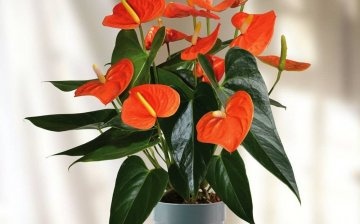
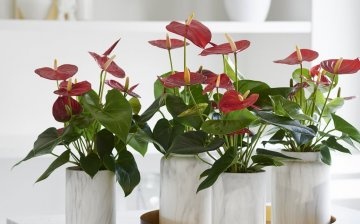
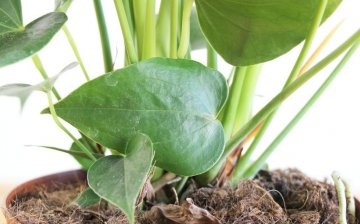
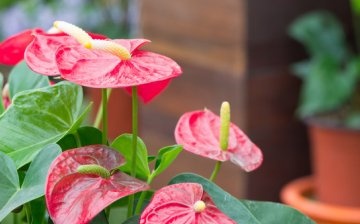






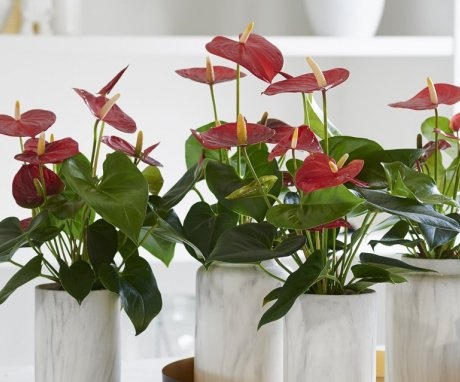


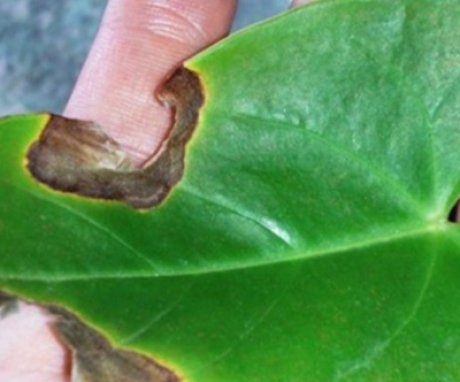
My Anthurium grew for about a year and was pretty good, it bloomed profusely, the leaves were large and rich green. But then, literally in an instant, the flower began to wither and eventually died. Based on the information from the article, I probably watered it too abundantly.